On-Page SEO Checklist: Optimize Your Money Pages for Leads

Is There a Kink in My Funnel? | Optimizing for Your MOFU Keywords
As SEO specialists, we often prioritize what we can control. We provide three blog articles a month, we acquire three links, and we can crawl our clients’ sites for technical errors. Those are all useful tactics, but we can’t forget how our inputs correlate with our clients’ marketing funnel.
If we are just focusing on the inputs that seem natural to us, we may be neglecting an essential stage within the funnel ultimately making our demand generation efforts futile. A typical result of this is seeing growth in traffic, but not seeing any impact in the pipeline.
To begin, let’s make sure we are all speaking the same language. Marketers have different ideas on what falls into what within each stage of the marketing funnel.
Therefore, below is a breakdown of what we, at Directive, believe the digital marketing stages are for a B2B company including TOFU (top of the funnel), MOFU (middle of the funnel), BOFU (bottom of the funnel) and how to benefit from them with B2B lead generation tips.

TOFU:
The purpose of top of funnel content is to generate brand awareness and perception amongst your target audience. I say perception because the goal isn’t to just get the users to your content.
47% of buyers view 3-5 pieces of content before engaging with a sales rep (Demand Gen Report, 2016.) Therefore, utilizing content to build awareness at the top of the funnel is still and will always be essential to increase B2B lead generation.
MOFU:
The whole point of nurturing at the top of the funnel is so that you can eventually be in the conversation when they are on the hunt for a solution to their problem.
In a perfect world, the next steps include…
- They have read so many of your blogs that they remember your brand when ready to purchase a solution.
- They type in your name into the search engine.
- They call your sales team.
- Then sign a $50,000 check for your amazing software.
Realistically…..
- They don’t remember your brand name off the top of their head.
- They type in different solutions for their problem.
- They refine it multiple times and check your product page ranking.
- They kind of recognize your brand name because they have read a few of your blogs or saw you at a conference a couple of years ago.
- They read through your page.
- They go back to the search engine to view other options, probably modifying their search with “best”, “top”, “reviews”, or “comparison.”
- They visit a 3rd party site that is ranking with all your competitors listed in it.
- They analyze the top 3 options by looking at reviews and case studies.
- They do demos with all three.
- They eliminate an option because it’s not the right fit.
- They do steps 7-9 again to identify another third option.
- They go through pros and cons of those three options to their boss.
- The boss tells them they don’t need the solution at the moment.
- They go home crying because they wasted a whole week doing research.
Okay, hopefully, they’re not experiencing the last two…but for those who have shopped for a new solution for their business know….the stakes are much higher!
I built this list from my own recent experience with purchasing some costly software for our company. When my reputation is on the line like this, I am doing my research. Therefore, I am spending a lot of time collecting information in the MOFU-BOFU stages before making a purchasing decision.
MOFU pages are usually set up as product, solution, service, or industry pages on our client’s websites, and they contain the most valuable keywords. They are typically targeting terms with the most buyer intent (buy bulk matcha tea, B2B SEO agency, sales enablement software.)
In our MOFU pages, we want to let the users know that we have the right solution for their problem.
SEO teams often look at these pages in their initial SEO audits, then forget them in the ongoing portion of the relationship. Keeping our eyes on the ball is vital!
Google ranks pages, not websites. We see this more and more when considering the updates that Google makes to its algorithm. For instance, Rankbrain uses machine learning to sort through the billions of PAGES it knows about and find the ones deemed most relevant for particular queries (Search Engine Land, 2016.)
BOFU:
Peer reviews have not just impacted local business through platforms like Yelp or B2C products through platforms like Amazon, but also B2B users.
They shop the same way.
We see this within the search engine results pages. Just type in your product or solution and add “best” to the beginning of it. Try it without even adding best. When searching the term “itsm software”…
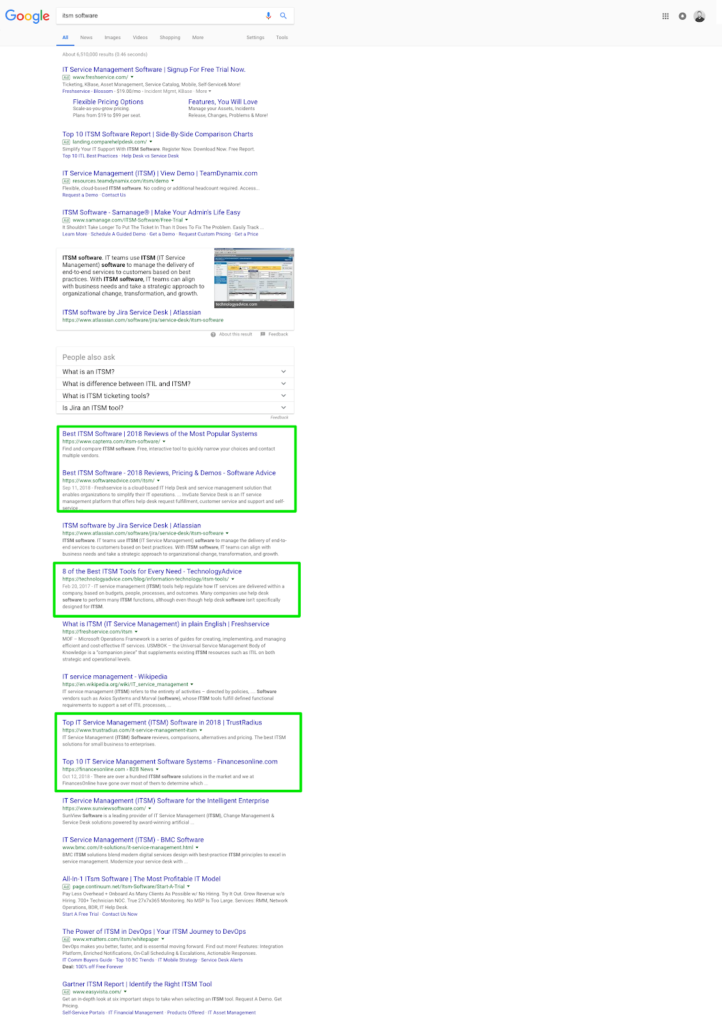
5 out of 10 results are third-party review sites!
Here is a screenshot of what Google suggests after you type in ITSM Software (which indicates the most popular modifying searches that users do after they type in “ITSM software”.)

Here are the results for this “itsm software comparison.”
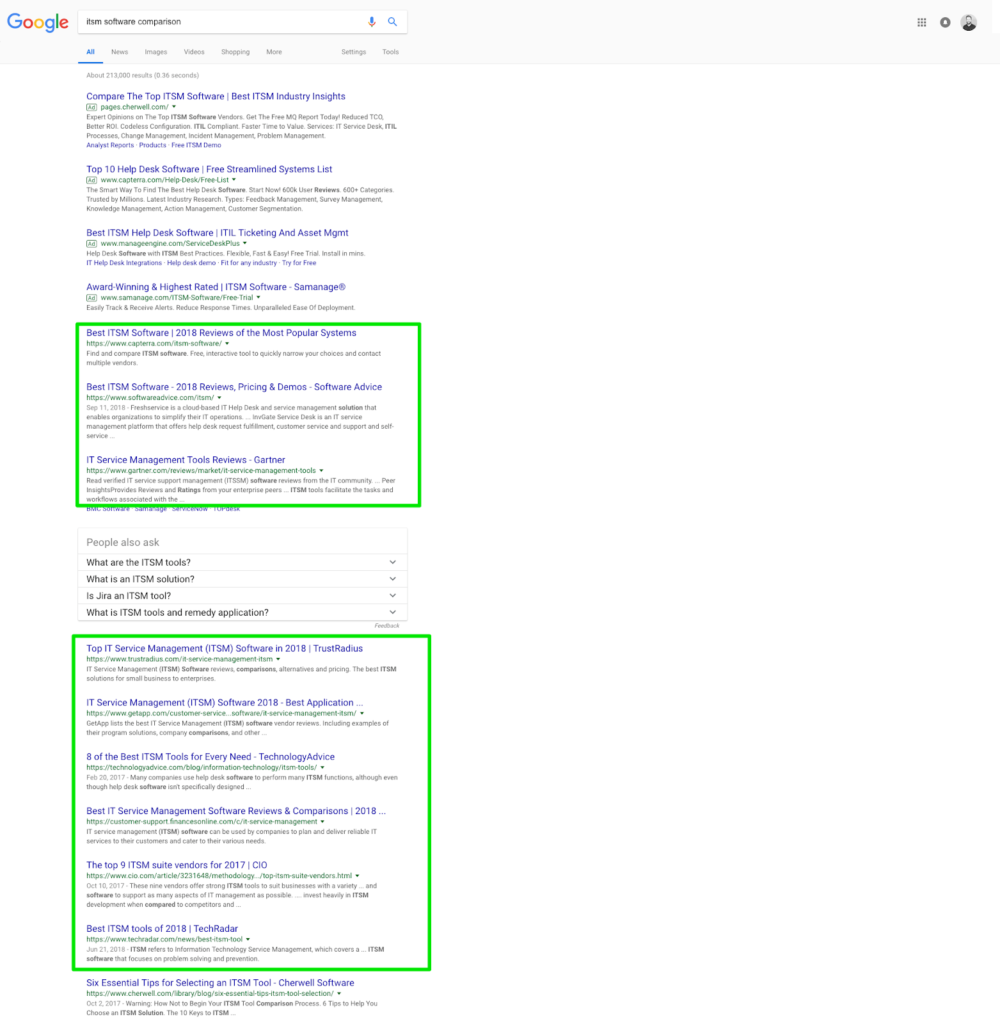
All third-party review sites!!
In the following checklist, I will be running through how to optimize your MOFU pages to overall increase B2B lead generation, but please don’t neglect review sites. This is where your users are making final decisions. I can’t share our clients’ opportunity data with you, but I can tell you that these review sites almost always outperform other channels in regards to MQL’s.
The Approach
When choosing which MOFU pages to start with, remember your goal, increase those lead generations! I like to start in the areas with the most significant impact – time is money.
Step one for me usually begins with focusing on the highest converting pages.
As straightforward as it sounds, If you have a converting page that is performing well, whether it is coming from organic traffic or other channels, it’s time to find new ways to get that page even more traffic.
In return, you can take the opposite approach by looking at high-traffic pages that aren’t converting well and focus on the conversion rate optimization of those pages. I usually recommend looking at both within Google Analytics and seeing if there are any outliers.
Once the outlier has been identified, I optimize for both SEO and CRO on the page.
Keyword Audit:
What Are You Targeting?
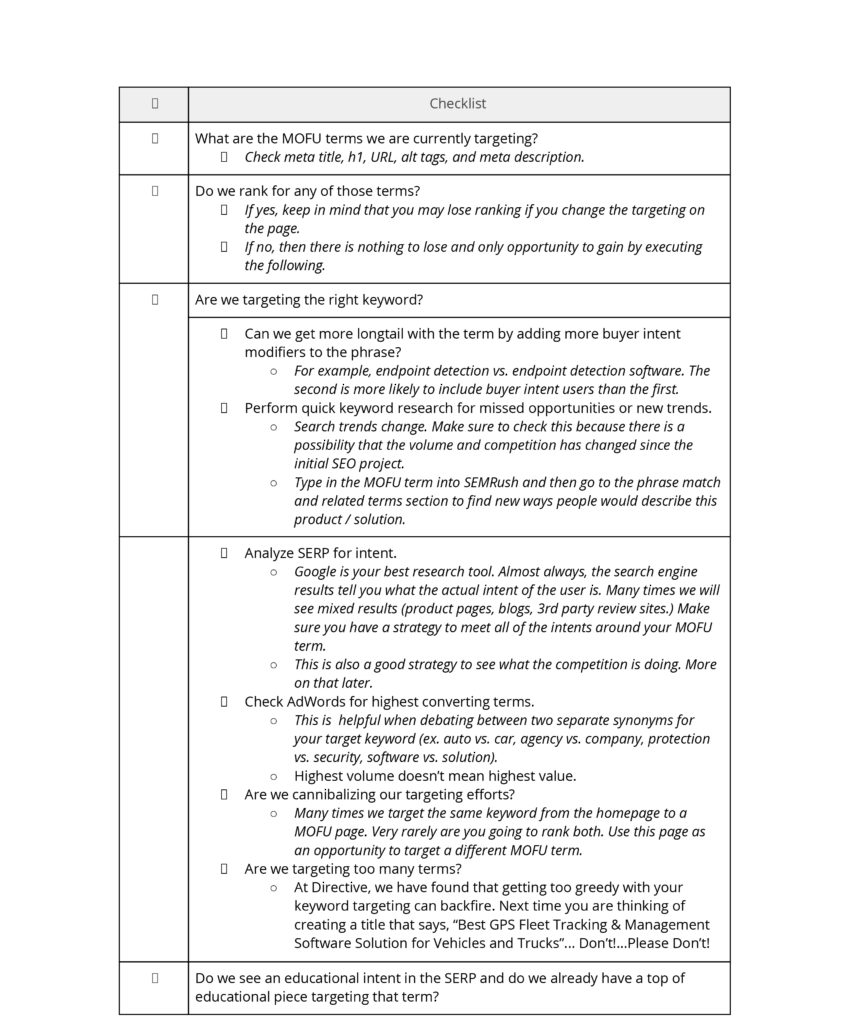
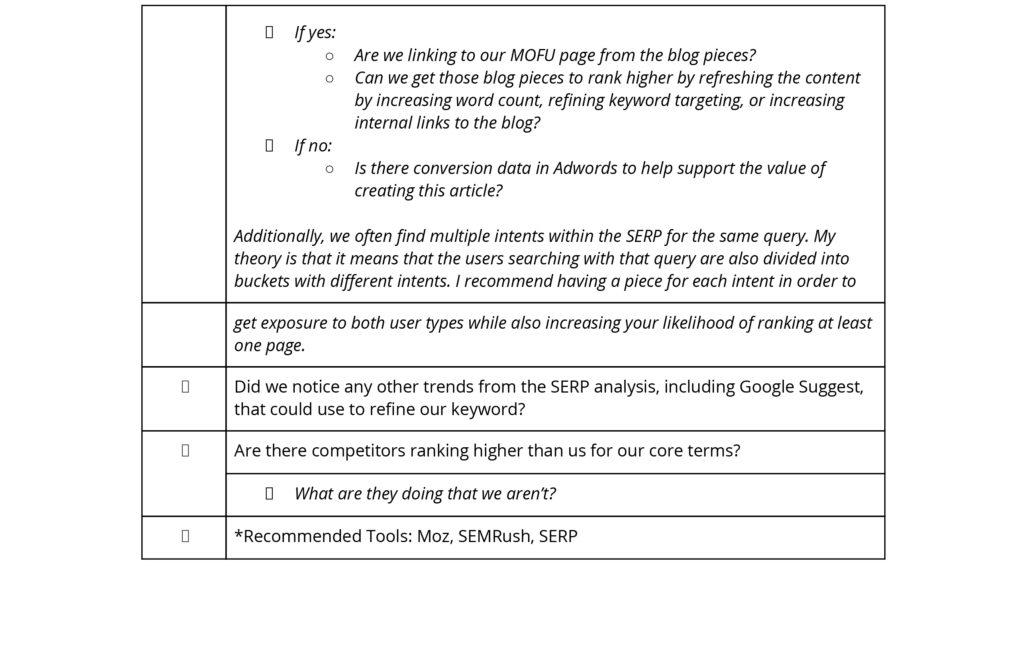
Are You Leveraging That Term on the Page?
The MOFU keyword should be placed in the following areas of the page:
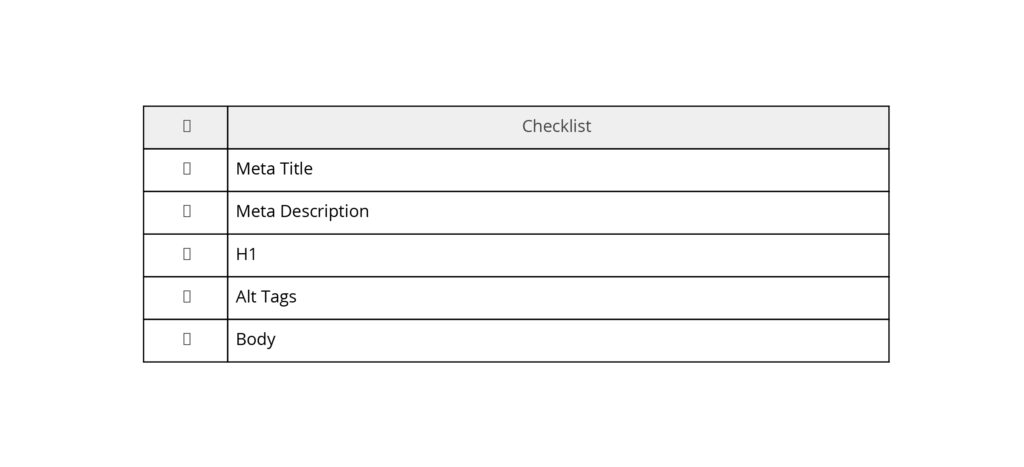 Is Your Meta Title User-Friendly?
Is Your Meta Title User-Friendly?
This isn’t a new revelation, and it has been covered very well by many thought leaders in the SEO space (click here.) Bottom-line: click-through-rate has an impact on rankings. We have tested this on our clients who have large sites and have seen similar results.
A good way to increase B2B lead generation? Make sure they can find your content. 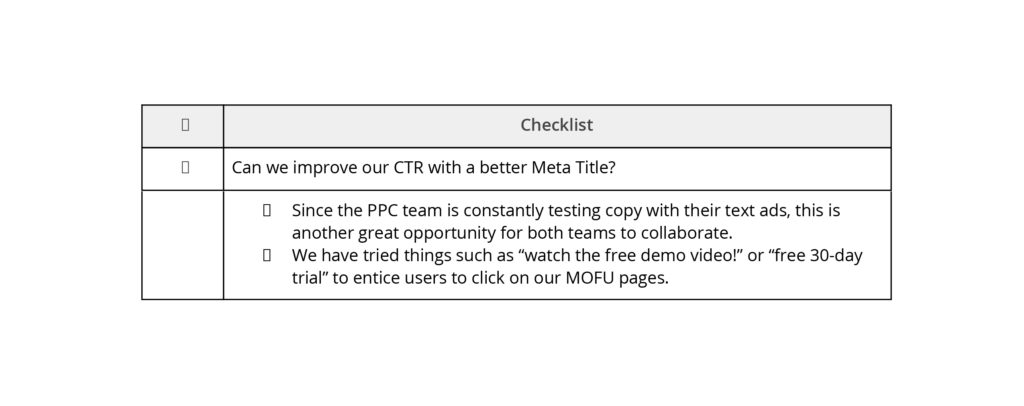
Technical Audit:
How Fast Does the Page Load?
Page speed should be a top priority, no exceptions. Not only does poor page speed have a direct adverse effect on rankings, but is also connected to other engagement metrics that also hurt rankings, such as bounce rate.
More importantly, it messes with your conversion rates. Check out this info from Hubspot to further explain these impacts.
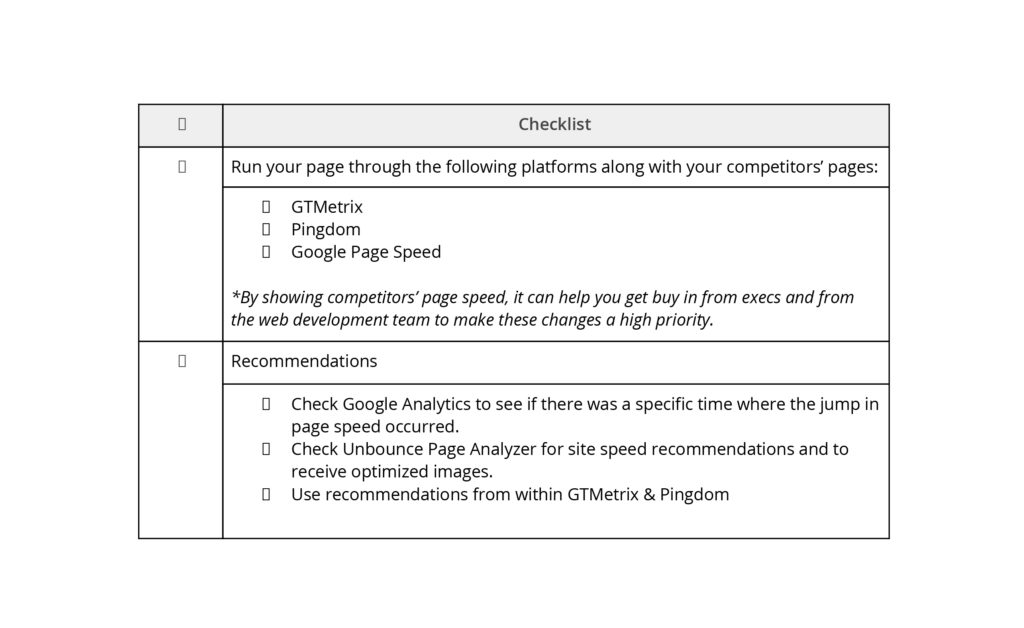 Site Architecture:
Site Architecture:
Sometimes as SEOs, we focus so much on receiving external links for our clients that we forget we are one of our most valuable links. Remember to find ways to link to your most beneficial pages proactively.
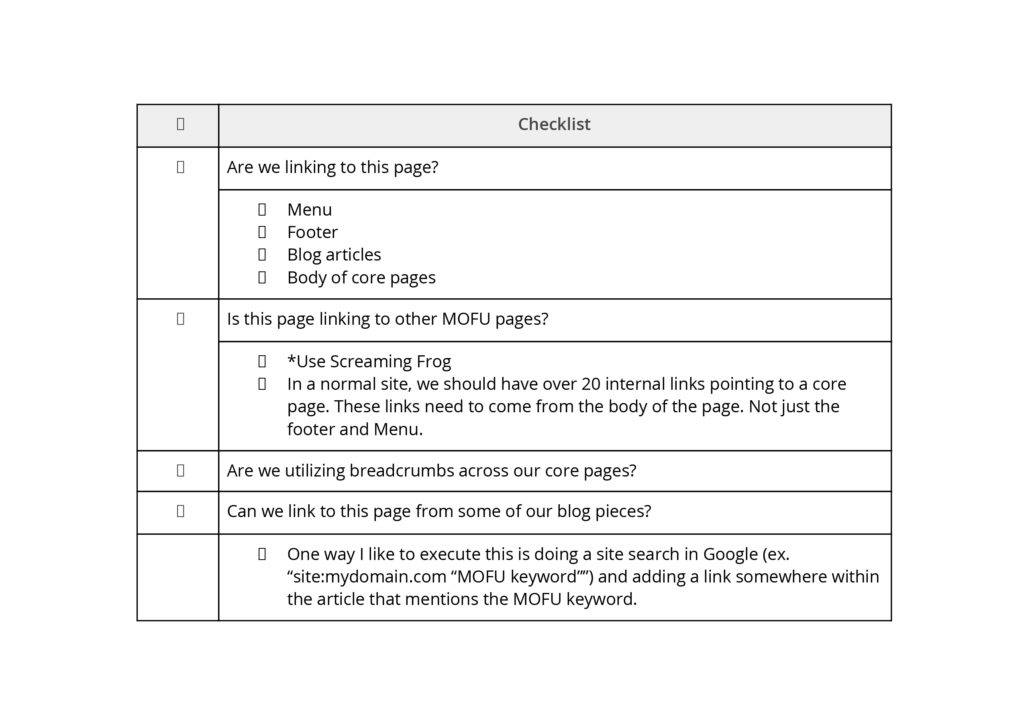 Other Technical Aspects:
Other Technical Aspects: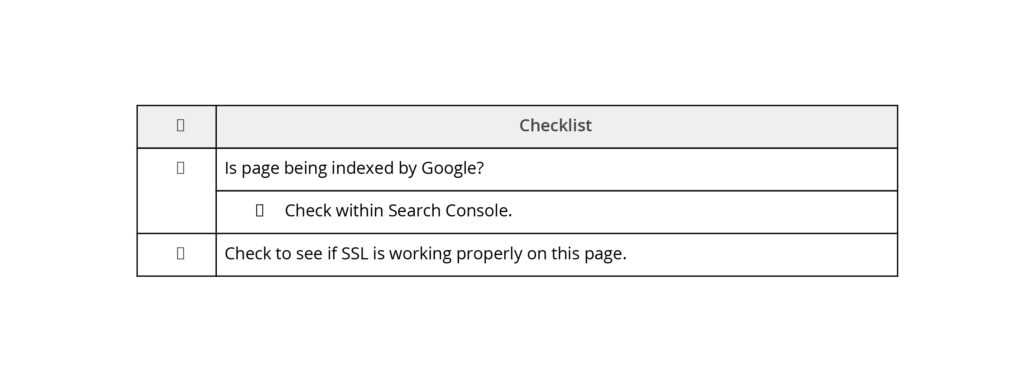 Page Authority Audit:
Page Authority Audit: Content Audit:
Content Audit:
Is Your Content Better Than What is Currently Ranking?
Getting the users to the page is half the battle. Once they’re there, you have to keep them engaged and entertained. Make sure your content is more quality and beneficial than your competitors.
It’s worth putting in a little bit more research and time to increase your lead generation!
Creating quality content is not just about word count and unique content ratio, but usability as well. Google is looking at engagement metrics as a ranking factor. 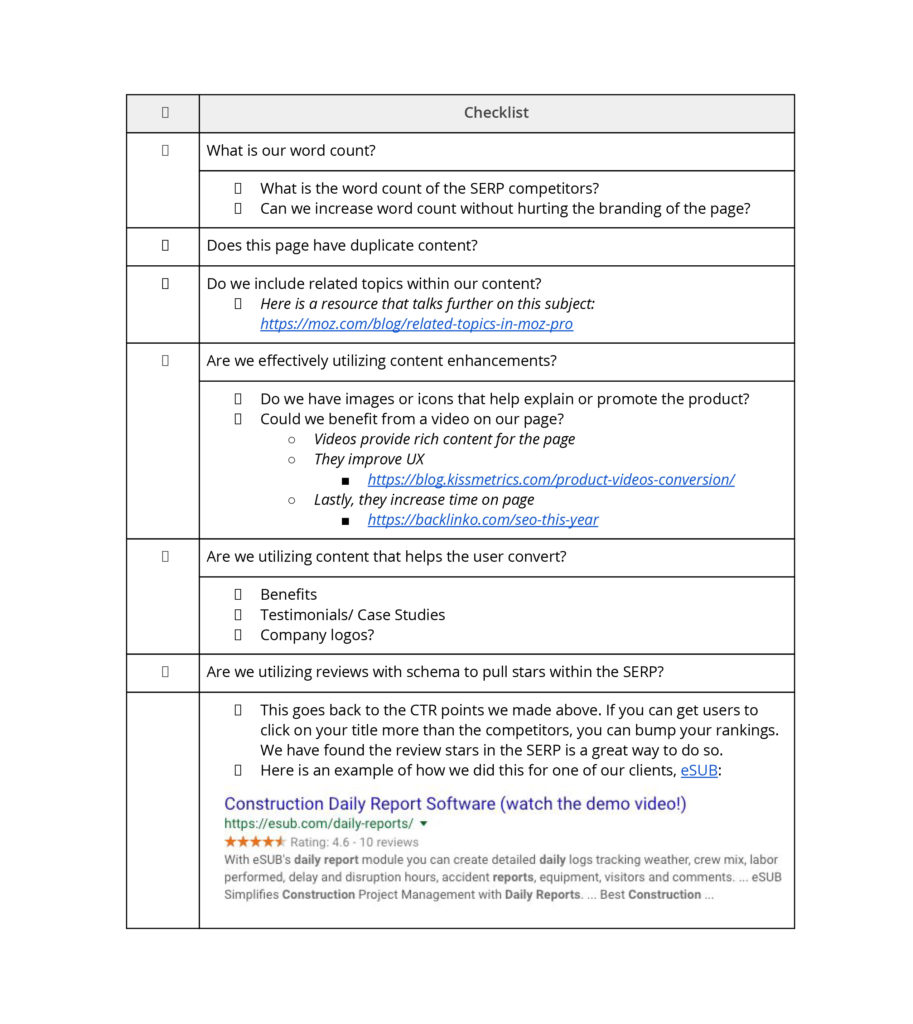
CRO Audit:
Treat Your MOFU pages Like PPC Landing Pages
Since our MOFU pages are ranking for buyer intent keywords, it is essential to treat them like we treat our PPC landing pages. They are both landing pages with the intent to increase lead generation.
Therefore, the same principles apply. Straightforward, yeah?
- Are you answering the users’ questions or are you expecting them to find those answers by exploring the rest of the website?
- Do you work with similar companies?
- Are you trustworthy?
- Do you offer what I am looking for?
- Do you have a compelling CTA above the fold?
- What is going to happen after I fill out the form?
Just a 1% increase in conversion rates can have a tremendous impact on total conversion count.
Therefore, we should dedicate time to continually optimizing these pages to increase lead generation.
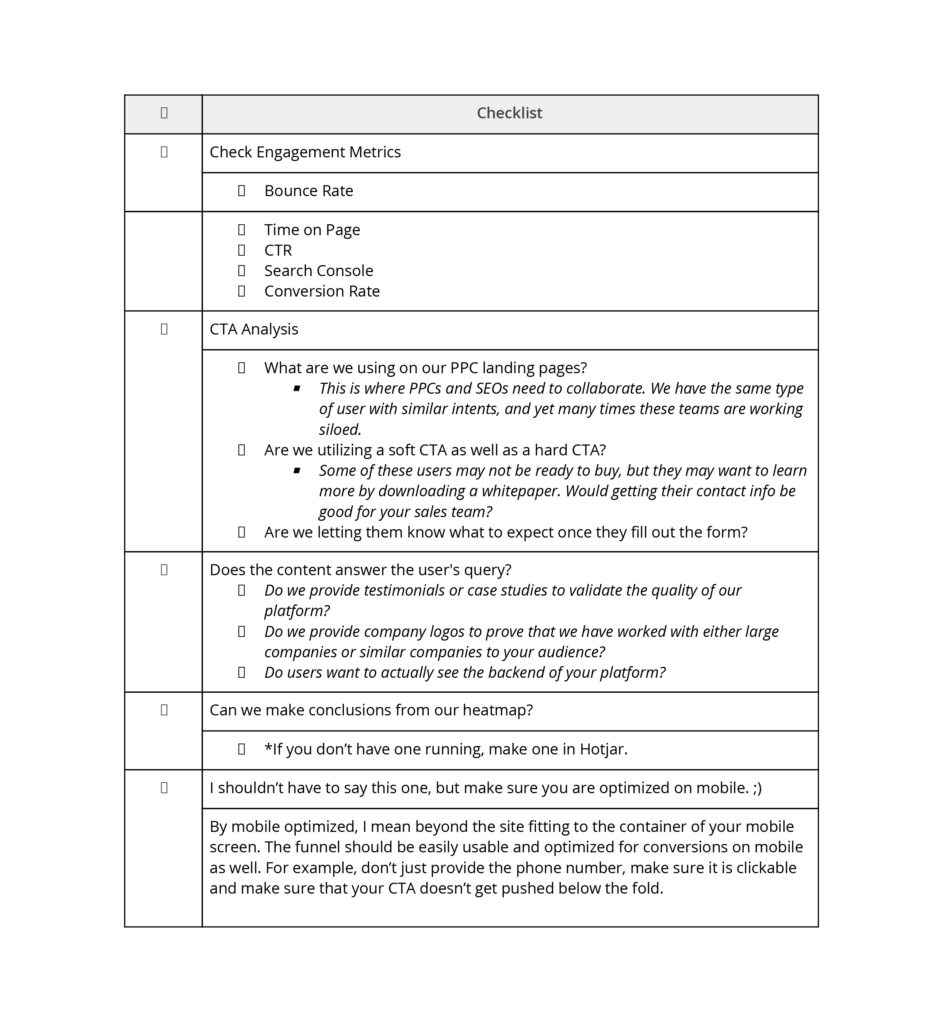
Overall, I hope this information helps give you a competitive edge on your MOFU pages. Remember, don’t get caught up in the scope of work line items.
Ultimately, the client hired you to drive qualified B2B leads. If you are neglecting a part of the funnel, you are limiting your impact. This list was built over time as I continually relooked at my clients MOFU pages. I added MOFU and BOFU optimization as a part of my recurring workflow.
Moving forward, keep learning as there will continue to be other great techniques out there you can add to your current SEO toolkit and increase your B2B lead generation.
Author Bio: Tanner Shaffer – COO / Co-founder
Tanner Shaffer is the co-founder and Chief Operations Officer of Directive, a leading B2B and enterprise search marketing agency headquartered in Irvine, California. Tanner, fascinated by the role search marketing plays in empowering companies and people to connect, has dedicated the past four years toward that passion.
Tanner is extremely driven and thrives off of hitting client goals. From SEO to PPC to account management, he has refined each deliverable to provide more value in an ever-changing industry.
Currently, he leads a group of directors who are continually inspiring a team of talented marketers to innovate their craft. With a 205% growth rate in company size, he is fixated on filling the company with people that have integrity and aspire to be great.
Tanner began his professional career by earning a Bachelor’s degree in Marketing from Azusa Pacific University. When he is not in meetings and working through excel sheets, he enjoys surfing, dirt-biking, and growing his relationship with God, his loving wife, and family.




